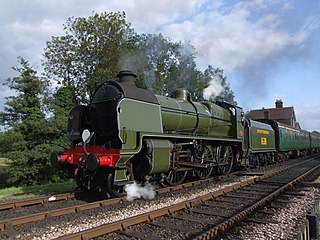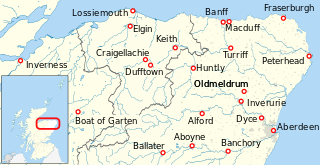
The London, Brighton and South Coast Railway was a railway company in the United Kingdom from 1846 to 1922. Its territory formed a rough triangle, with London at its apex, practically the whole coastline of Sussex as its base, and a large part of Surrey. It was bounded on its western side by the London and South Western Railway (L&SWR), which provided an alternative route to Portsmouth. On its eastern side the LB&SCR was bounded by the South Eastern Railway (SER)—later one component of the South Eastern and Chatham Railway (SE&CR)—which provided an alternative route to Bexhill, St Leonards-on-Sea, and Hastings. The LB&SCR had the most direct routes from London to the south coast seaside resorts of Brighton, Eastbourne, Worthing, Littlehampton and Bognor Regis, and to the ports of Newhaven and Shoreham-by-Sea. It served the inland towns and cities of Chichester, Horsham, East Grinstead and Lewes, and jointly served Croydon, Tunbridge Wells, Dorking and Guildford. At the London end was a complicated suburban and outer-suburban network of lines emanating from London Bridge and Victoria, and shared interests in two cross-London lines.
The Southern Railway took a key role in expanding the 660 V DC third rail electrified network begun by the London & South Western Railway. As a result of this, and its smaller operating area, its steam locomotive stock was the smallest of the 'Big Four' companies.
The SR N15X class or Remembrance class were a design of British 4-6-0 steam locomotives converted in 1934 by Richard Maunsell of the Southern Railway from the large LB&SCR L class 4-6-4 tank locomotives that had become redundant on the London–Brighton line following electrification. It was hoped that further service could be obtained from these locomotives on the Southern's Western Section, sharing the duties of the N15 class locomotives. The locomotives were named after famous Victorian engineers except for Remembrance, which was the LBSCR's memorial locomotive for staff members who died in the First World War.

The LSWR N15 class was a British 2–cylinder 4-6-0 express passenger steam locomotive designed by Robert Urie. The class has a complex build history spanning three sub-classes and ten years of construction from 1918 to 1927. The first batch of the class was constructed for the London and South Western Railway (LSWR), where they hauled heavy express passenger trains to the south coast ports and further west to Exeter. After the Lord Nelsons, they were the second biggest 4-6-0 passenger locomotives on the Southern Railway. They could reach speeds of up to 90 mph (145 km/h).

The London, Brighton and South Coast Railway (LB&SCR) A1 class is a class of British 0-6-0T steam locomotive. Designed by William Stroudley, 50 members of the class were built in 1872 and between 1874 and 1880, all at Brighton railway works. The class has received several nicknames, initially being known as "Rooters" by their south London crews. However, the engines were more famously known as "Terriers" on account of the distinctive 'bark' of the exhaust beat. Later in their careers, some engines were known as "Hayling Billy" on account of their work on the Hayling Island branch line. A pub of this name on the island was briefly home to the engine which is now No. W8 Freshwater.

Brighton railway works was one of the earliest railway-owned locomotive repair works, founded in 1840 by the London and Brighton Railway in Brighton, England, and thus pre-dating the more famous railway works at Crewe, Doncaster and Swindon. The works grew steadily between 1841 and 1900 but efficient operation was always hampered by the restricted site, and there were several plans to close it and move the facility elsewhere. Nevertheless, between 1852 and 1957 more than 1200 steam locomotives as well as prototype diesel electric and electric locomotives were constructed there, before the eventual closure of the facility in 1962.

The SR U class are 2-6-0 steam locomotives designed by Richard Maunsell for passenger duties on the Southern Railway (SR). The class represented the penultimate stage in the development of the Southern Railway's 2-6-0 "family", which improved upon the basic principles established by GWR Chief Mechanical Engineer (CME) George Jackson Churchward for Great Western Railway (GWR) locomotives. The U class design drew from experience with the GWR 4300s and N classes, improved by applying Midland Railway ideas to the design, enabling the SECR to influence development of the 2-6-0 in Britain.

The NBR C Class is a class of 0-6-0 steam locomotives designed by Matthew Holmes for freight work on the North British Railway (NBR). They were introduced in 1888 with inside cylinders and Stephenson valve gear. A total of 168 locomotives was built, of which 123 came into British Railways ownership at nationalisation in 1948. This was the last class of steam engine in service in Scotland.

The South Eastern and Chatham Railway (SECR) P class is a class of 0-6-0T steam locomotive designed by Harry Wainwright.

The London, Brighton and South Coast Railway E4 class is a class of 0-6-2T side tank steam locomotive designed by Robert Billinton. They were introduced in 1897 and were essentially a larger version of the E3 Class. The cylinder diameter was reduced from 18 to 17.5 inches by the Southern Railway.

The South Eastern Railway (SER) O Class was a class of 0-6-0 steam locomotive designed for goods work, and were the main goods engines of the SER, and later the South Eastern and Chatham Railway (SECR) for a number of years. However, they were displaced by the more powerful C class locomotives following the amalgamation of the South Eastern Railway and London, Chatham and Dover Railway (LCDR) in 1899. This relegated the class to working on the numerous branch lines in Kent, on both passenger and goods work. They worked most notably on the Kent & East Sussex Railway and East Kent Railway, operating coal trains from the Kent coal fields to London, as well as shunting work at such locations as Shepherds Well, Hoo Junction and Ashford. The majority were withdrawn before the outbreak of the Second World War in 1939, and those that remained were slowly withdrawn from nationalisation onwards.

The London and North Eastern Railway (LNER) D40 class is a type of 4-4-0 steam locomotive inherited from the Great North of Scotland Railway (GNSR). It consisted of GNSR class V and GNSR class F. The two classes were similar but the class F was superheated.

The SECR N class was a type of 2-6-0 ("mogul") steam locomotive designed in 1914 by Richard Maunsell for mixed-traffic duties on the South Eastern and Chatham Railway (SECR). Built between 1917 and 1934, it was the first non-Great Western Railway (GWR) type to use and improve upon the basic design principles established by GWR Chief Mechanical Engineer (CME) George Jackson Churchward. The N class was based on the GWR 4300 Class design, improved with Midland Railway concepts.

The LB&SCR K class were powerful 2-6-0 mixed traffic locomotives designed by L. B. Billinton for the London, Brighton and South Coast Railway (LB&SCR) in 1913. They appeared shortly before the First World War and the first ten examples of the class did prodigious work during that conflict on munitions, supply and troop trains. Further examples were built after the war, and the class was used as a test bed for various items of specialised equipment. However, after the formation of the Southern Railway in 1923 the remaining three locomotives on order were not completed and the seventeen members of the class led relatively quiet yet reliable lives over their traditional lines. The locomotives proved their usefulness once again during the Second World War, and continued to provide reliable service until the 1960s. The entire class was eventually withdrawn in 1962 for 'bookkeeping' rather than 'operational' reasons.

The SECR N1 class was a type of 3-cylinder 2-6-0 ('mogul') steam locomotive designed by Richard Maunsell for mixed traffic duties, initially on the South Eastern and Chatham Railway (SECR), and later operated for the Southern Railway (SR). The N1 was a development of the basic principles established by the Great Western Railway's (GWR) Chief Mechanical Engineer (CME) George Jackson Churchward and by Maunsell's previous N class design.

The SECR K class was a type of 2-6-4 tank locomotive designed in 1914 by Richard Maunsell for express passenger duties on the South Eastern and Chatham Railway (SECR), which operated between London and south-east England. The Southern Railway (SR) K1 class was a three-cylinder variant of the K class, designed in 1925 to suit a narrower loading gauge. They were among the first non-Great Western Railway (GWR) types to use and improve upon the basic design principles of power and standardisation established by GWR Chief Mechanical Engineer (CME) George Jackson Churchward. The locomotives were based on the GWR 4300 class, improved by the Midland Railway's ideals of simplicity and ease of maintenance.
The Railway Children is a 2000 drama television film based on the 1906 novel by E. Nesbit. It was broadcast for the first time in the United Kingdom on 23 April 2000. Shortly afterwards, it was shown in the United States on the series Masterpiece Theatre.

The locomotives of the Great North of Scotland Railway were used by the Great North of Scotland Railway to operate its lines in the far north-east of the country. The railway opened in 1854 with just five 2-4-0 steam locomotives, and from 1862 it used 4-4-0 exclusively as the wheel arrangement for its tender locomotives. When it expanded by amalgamation in 1866, it inherited some locomotives from these companies. It purchased most of its locomotives, although building a small number itself, two at its first works at Kittybrewster, and ten later at Inverurie Locomotive Works.

The Great Northern Railway Class A1 1470 Great Northern was the first of 52 A1 class locomotives. It has also represented three distinct stages in the history of the British 4-6-2 "Pacific" steam locomotives designed by Nigel Gresley for the Great Northern Railway (GNR), a constituent company of the London and North Eastern Railway before the amalgamation of 1923, for which they became a standard design. Eventually Great Northern was completely rebuilt as Class A1/1.

London, Brighton and South Coast Railway E4 class number 473 Birch Grove is an LB&SCR E4 class 0-6-2T tank engine built in 1898 at Brighton Works for the LB&SCR, the locomotive primarily performed suburban passenger duties, and later did local passenger, freight, and branch work for almost fifty years, which is currently preserved on the Bluebell Railway. Initially painted in Stroudley's famous "Improved Engine Green", in 1912 it was later reboilered by D. E. Marsh with an I1-type boiler, and re-painted in dark umber livery.

















